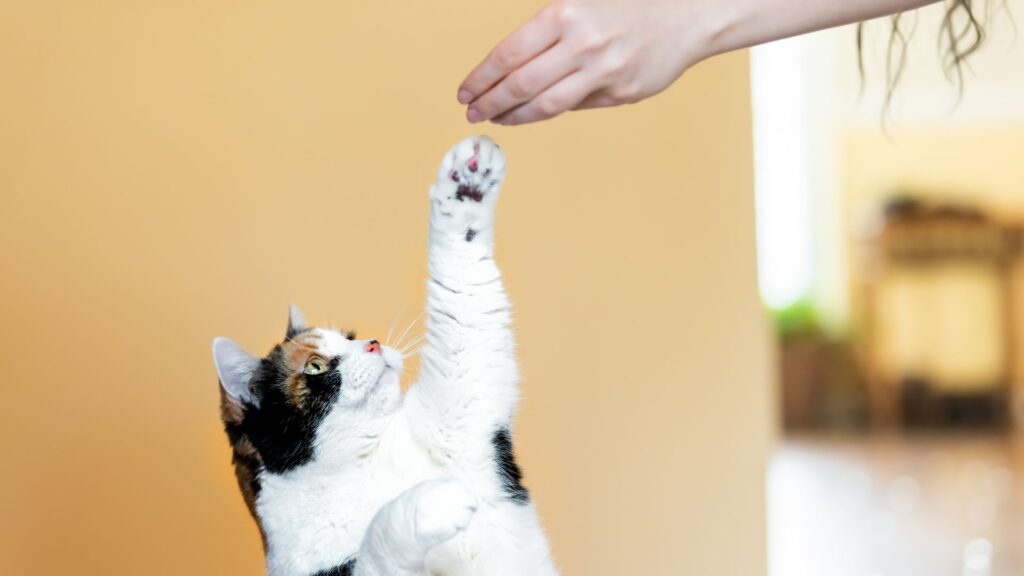Learn effective cat training tips and easy cat training steps to improve your feline’s behavior. Discover how to train your cat at home with simple, proven methods.
Cats are known for their independent spirit, but that doesn’t mean they can’t learn good manners or even fun tricks. If you’ve ever wished your feline friend would stop scratching the furniture, stop jumping on counters, or come when called, this guide on how to train your cat is exactly what you need. Training your cat not only improves their behavior but also strengthens your bond and enriches their lives.
In this comprehensive article, we’ll explore practical cat training tips, easy-to-follow cat training steps, and effective cat training methods you can use to shape your cat’s behavior right at home. Whether you want to teach basic obedience or fun tricks, this guide covers it all with a friendly, approachable style that suits any cat owner.

Teach cat tricks using patience and treats. Start with simple commands like “sit” or “high five,” rewarding your cat each time they succeed. Consistent practice makes learning fun and strengthens your bond.
Simple cat training focuses on easy, clear commands and positive rewards. By keeping sessions short and consistent, you can teach your cat good habits and basic tricks without stress for both of you.
Why Train Your Cat? Understanding Cat Behavior
Before diving into training, it’s important to understand why cats behave the way they do. Cats communicate through body language and vocalization, and many “problem behaviors” are just natural instincts — scratching to sharpen claws, jumping to explore, or meowing to seek attention.
Training your cat helps redirect these natural behaviors in positive ways, making life easier and more enjoyable for both of you.
Benefits of Training Your Cat:
- Reduces destructive behavior
- Enhances mental stimulation and reduces boredom
- Improves communication between you and your cat
- Encourages physical activity and healthy habits
- Strengthens your bond
Key Principles of Cat Training
Successful cat training relies on these core principles:
1. Positive Reinforcement
Reward-based training works best with cats. Use treats, praise, or playtime as rewards to encourage good behavior.
2. Consistency
Stick to your training plan every day. Consistent commands and rewards help your cat understand what’s expected.
3. Patience
Cats learn at their own pace. Don’t rush or punish, as negative reactions can harm trust.
4. Short Sessions
Cats have short attention spans. Train in 5-10 minute sessions multiple times daily.

Step-by-Step Guide: How to Train Your Cat at Home
Step 1: Create a Safe, Comfortable Environment
Your cat should feel secure before training. Choose a quiet space free of distractions.
Step 2: Identify the Behavior to Train
Focus on one behavior at a time — scratching, litter use, jumping, or coming when called.
Step 3: Gather Training Supplies
Prepare small treats, a clicker (optional), and toys for positive reinforcement.
Step 4: Use Clear Commands
Use simple words like “No,” “Come,” or “Sit.” Say the command once clearly during training.
Step 5: Reward Immediately
Give treats or praise immediately when your cat performs the desired behavior.
Step 6: Redirect Undesired Behavior
If your cat scratches furniture, gently redirect them to a scratching post and reward when used.
Step 7: Be Patient and Consistent
Repeat sessions daily and gradually increase difficulty.
Step 8: Teach Fun Tricks
Once basic obedience is mastered, try teaching tricks like “sit,” “high five,” or “fetch.”
Common Cat Behaviors and How to Train Them
Scratching Furniture
- Provide scratching posts or pads
- Reward use of posts immediately
- Use deterrents like double-sided tape on furniture
Jumping on Counters
- Use a firm “No” and gently remove cat
- Provide alternative elevated spaces like cat trees
- Reward jumping on approved areas
Litter Box Issues
- Keep litter box clean
- Use the same type of litter consistently
- Reward proper use and consult a vet if problems persist
Come When Called
- Use a consistent call word (e.g., “Here kitty”)
- Reward immediately with treats or affection
- Practice regularly in low-distraction areas
Cat Training Tips for Success
- Use high-value treats your cat loves
- Avoid punishment; it damages trust
- Observe your cat’s mood and stop if stressed
- Vary training activities to keep it fun
- Use clicker training for precise rewards
Real-World Examples
Example 1:
Sarah’s cat scratched her sofa constantly. She placed a scratching post nearby, rewarded her cat whenever it used the post, and gently discouraged sofa scratching with double-sided tape. Within two weeks, the cat learned to prefer the post.
Example 2:
Mike wanted his cat to come when called. Using dry food treats, he called his cat during meal times and rewarded immediately. After a month of daily training, the cat reliably came when called.

Tools and Products to Help Train Your Cat
| Product | Purpose | Price Range |
|---|---|---|
| Clicker | Mark desired behavior | $5 – $15 |
| Treat Pouch | Hold treats for easy access | $10 – $20 |
| Scratching Post | Redirect scratching | $20 – $50 |
| Cat Tree | Provide climbing alternatives | $50 – $150 |
| Interactive Toys | Keep cat engaged | $10 – $30 |
Suggested Outbound Links to Add:
- When discussing positive reinforcement training:
Link to the ASPCA’s guide on cat training techniques —
ASPCA Cat Training Tips - For understanding cat behavior and body language:
Link to the American Humane Society’s cat behavior page —
American Humane Cat Behavior - When recommending clicker training:
Link to the Humane Society’s clicker training explanation —
Humane Society Clicker Training - On litter box training tips:
Reference Jackson Galaxy’s expert advice —
Jackson Galaxy Litter Box Tips
FAQs About Training Your Cat
1. How long does it take to train a cat?
Training length varies, but simple commands may take a few weeks of consistent sessions.
2. Can all cats be trained?
Yes, though some breeds or personalities may respond faster or slower.
3. Is punishment effective for cat training?
No, punishment can harm your relationship and cause fear or aggression.
4. What if my cat ignores training?
Try different treats, keep sessions short, and ensure training is positive.
5. Can I train an older cat?
Absolutely! Older cats can learn new behaviors with patience.
What’s New in Cat Training for 2025?
- Use of technology like automated treat dispensers and cat training apps
- Increased focus on mental enrichment alongside obedience
- Innovations in clicker devices for wireless training
- Growing trend of online cat training classes and video tutorials
Conclusion
Training your cat might seem challenging, but with the right approach and patience, you can enjoy a well-behaved, happier feline companion. Remember to use positive reinforcement, keep sessions short, and celebrate small wins. Start with simple behaviors, and soon you’ll be teaching your cat fun tricks too!
Ready to start training your cat? Share your experiences or questions in the comments below and sign up for our newsletter to get more expert tips and guides straight to your inbox!



